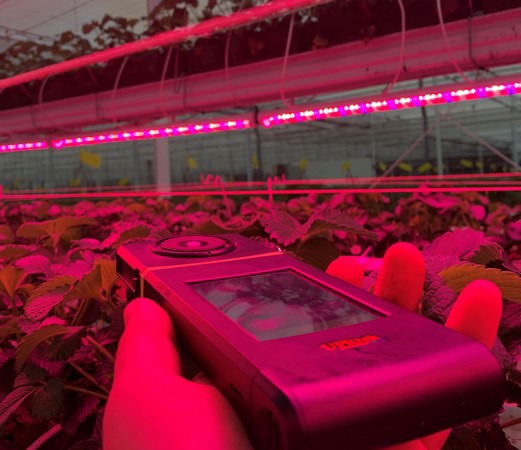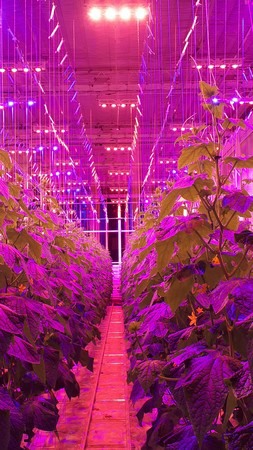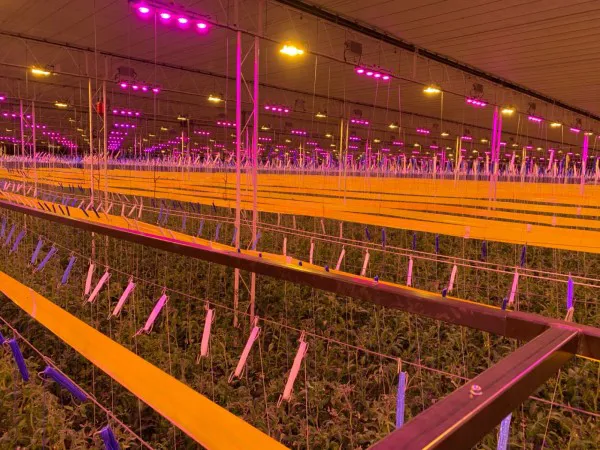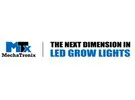"How much far-red light plants need, changes during the season and even during the day," says Koen of MechaTronix. Lighting with an adjustable partial spectrum allows for this kind of control: the standard spectrum remains the same and the intensity of red and far-red light can be adjusted. "You only have dynamically what you want to have dynamically.” We expect that all lighting will be dynamic eventually.
 Dynamic lighting
Dynamic lighting
Dynamic lighting is already well established in greenhouse horticulture and indoor cultivation. These are fittings where the intensity of the light can be adjusted. What is new, is lighting with dynamic spectrums, where the light recipe can be adjusted. Research centers have been working with this for some time: they can test different light recipes without having to buy new lamps every time. MechaTronix also offers lamps with these qualities (picture on the right).
 "A dynamic fitting is good for research, but for the time being it is far too expensive for ordinary cultivation and even for vertical farming," says Koen Vangorp. “The grower would have too much of everything: too much red, too much blue, too much green. This is economically unfeasible, both in terms of investment and energy consumption.” Moreover, according to him, it is not necessary at the moment. “A fixed basic recipe is enough to get you a long way.”
"A dynamic fitting is good for research, but for the time being it is far too expensive for ordinary cultivation and even for vertical farming," says Koen Vangorp. “The grower would have too much of everything: too much red, too much blue, too much green. This is economically unfeasible, both in terms of investment and energy consumption.” Moreover, according to him, it is not necessary at the moment. “A fixed basic recipe is enough to get you a long way.”
Controllable partial spectrum
A controllable partial spectrum is more important for growers. This allows the intensity of a part of the spectrum to be adjusted: for example, more far-red or green, or only extra blue. "With a controllable spectrum, you only have dynamically what you want to have dynamically”, Koen explains. “Then you can give the plant what it needs.”
And what a plant needs in many cultivations is far-red light. “You get the best yield when you play with the PSS: the phytochrome balance or the amount of far-red light compared to red light. It means that in your main spectrum you do not always add far-red light, but only give it when it is necessary.”
It is knowledge that comes from nature. "Just as we imitate the shade avoidance effect from nature in order to stretch plants more with the help of far-red light, with variable light we can give signals to the plant in more ways. A good example is the end-of-the-day-treatment where extra far-red light is given and the red from your light recipe needs to go down a bit. As a result, the plant gets a signal that it is in the shade of another plant and a natural extension occurs which ensures longer internodes and an open crop.”
 When?
When?
When that extra far-red is needed, depends on the crop and even the variety. “You can even see with different varieties of basil that some varieties need it and others don't. And not during the whole season", Koen continues.
The company participates in various Belgian and Dutch studies with their dynamic LED solution Coolstack MAX to learn more about this. "With different plants, including strawberries in a multilayer cultivation, far-red light comes in handy in part of the cultivation cycle to stretch the plant."
In the cultivation of Succulent salicornia, it concerns rooting and in soft herbs sometimes germination. "In fruit vegetables, the transportation of sugars to the fruit is stimulated with far-red light. So, we know more and more about how far-red light is optimal for the plant, and with the dynamic partial spectrum we make sure that it is also available for growers.”
For more information: 
MechaTronix
www.horti-growlight.com
Patrick Casteleyn
pcasteleyn@mechatronix-asia.com
